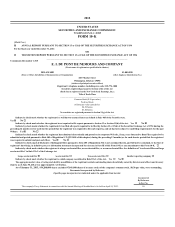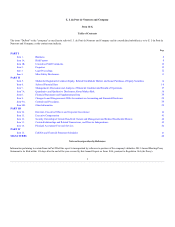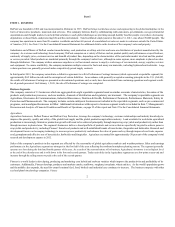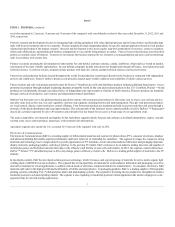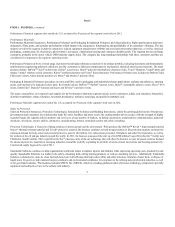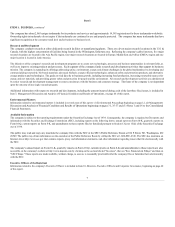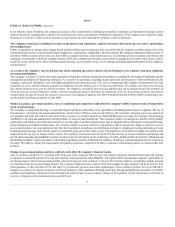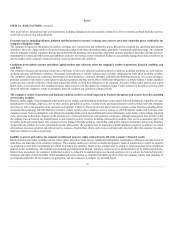DuPont 2012 Annual Report Download - page 10
Download and view the complete annual report
Please find page 10 of the 2012 DuPont annual report below. You can navigate through the pages in the report by either clicking on the pages listed below, or by using the keyword search tool below to find specific information within the annual report.
continued
In the ordinary course of business, the company may make certain commitments, including representations, warranties and indemnities relating to current
and past operations, including those related to divested businesses and issue guarantees of third party obligations. If the company were required to make
payments as a result, they could exceed the amounts accrued, thereby adversely affecting the company's results of operations.
Failure to appropriately manage safety, human health, product liability and environmental risks associated with the company's products, product life cycles
and production processes could adversely impact employees, communities, stakeholders, the environment, the company's reputation and its results of
operations. Public perception of the risks associated with the company's products and production processes could impact product acceptance and influence the
regulatory environment in which the company operates. While the company has procedures and controls to manage process safety risks, issues could be
created by events outside of its control including natural disasters, severe weather events, acts of sabotage and substandard performance by the company's
external partners.
The company is subject to various laws and regulations around the world governing the environment, including the discharge of pollutants and the
management and disposal of hazardous substances. As a result of its operations, including its past operations and operations of divested businesses, the
company could incur substantial costs, including remediation and restoration costs. The costs of complying with complex environmental laws and
regulations, as well as internal voluntary programs, are significant and will continue to be so for the foreseeable future. The ultimate costs under environmental
laws and the timing of these costs are difficult to predict. The company's accruals for such costs and liabilities may not be adequate because the estimates on
which the accruals are based depend on a number of factors including the nature of the matter, the complexity of the site, site geology, the nature and extent of
contamination, the type of remedy, the outcome of discussions with regulatory agencies and other Potentially Responsible Parties (PRPs) at multi-party sites
and the number and financial viability of other PRPs.
The company is using biotechnology to create and improve products, particularly in its Agriculture and Industrial Biosciences segments. The use of
biotechnology to characterize the genetic and performance characteristics of Pioneer seeds provides Pioneer with competitive advantages in the development of
new products, and in the most effective placement of those products on customer planted area. Industrial Biosciences leverages the company's biotechnology
capabilities to develop and manufacture a broad portfolio of enzymes and biomaterials. These products enable cost and process benefits, better product
performance and improve environmental outcomes to a broad range of products and processes such as animal nutrition, detergents, food manufacturing,
ethanol production and industrial applications. The company's ability to generate sales from such products could be impacted by market acceptance as well as
governmental policies, laws and regulations that affect the development, manufacture and distribution of products, including the testing and planting of seeds
containing biotechnology traits and the import of commodity grain grown from those seeds. The regulatory environment is lengthy and complex with
requirements that can vary by industry and by country. The regulatory environment may be impacted by the activities of non-governmental organizations and
special interest groups and stakeholder reaction to actual or perceived impacts of new technology on safety, health and the environment. Obtaining and
maintaining regulatory approvals requires submitting a significant amount of information and data, which may require participation from technology
providers. The ability to satisfy the requirements of regulatory agencies is essential to be able to continue to sell existing products or commercialize new
products.
Sales to customers outside the U.S. constitute about 60 percent of the company's 2012 revenue. The company anticipates that international sales will continue
to represent a substantial portion of its total sales and that continued growth and profitability will require further international expansion, particularly in
developing markets. Sales from developing markets represent 34 percent of the company's revenue in 2012 and the company's growth plans include focusing
on expanding its presence in developing markets. The company's financial results could be affected by changes in trade, monetary and fiscal policies, laws
and regulations, or other activities of U.S. and non-U.S. governments, agencies and similar organizations. These conditions include, but are not limited to,
changes in a country's or region's economic or political conditions, trade regulations affecting production, pricing and marketing of products, local labor
conditions and regulations, reduced protection of intellectual property rights in some countries, changes in the regulatory or legal environment, restrictions on
currency exchange activities, burdensome taxes and tariffs and
9

